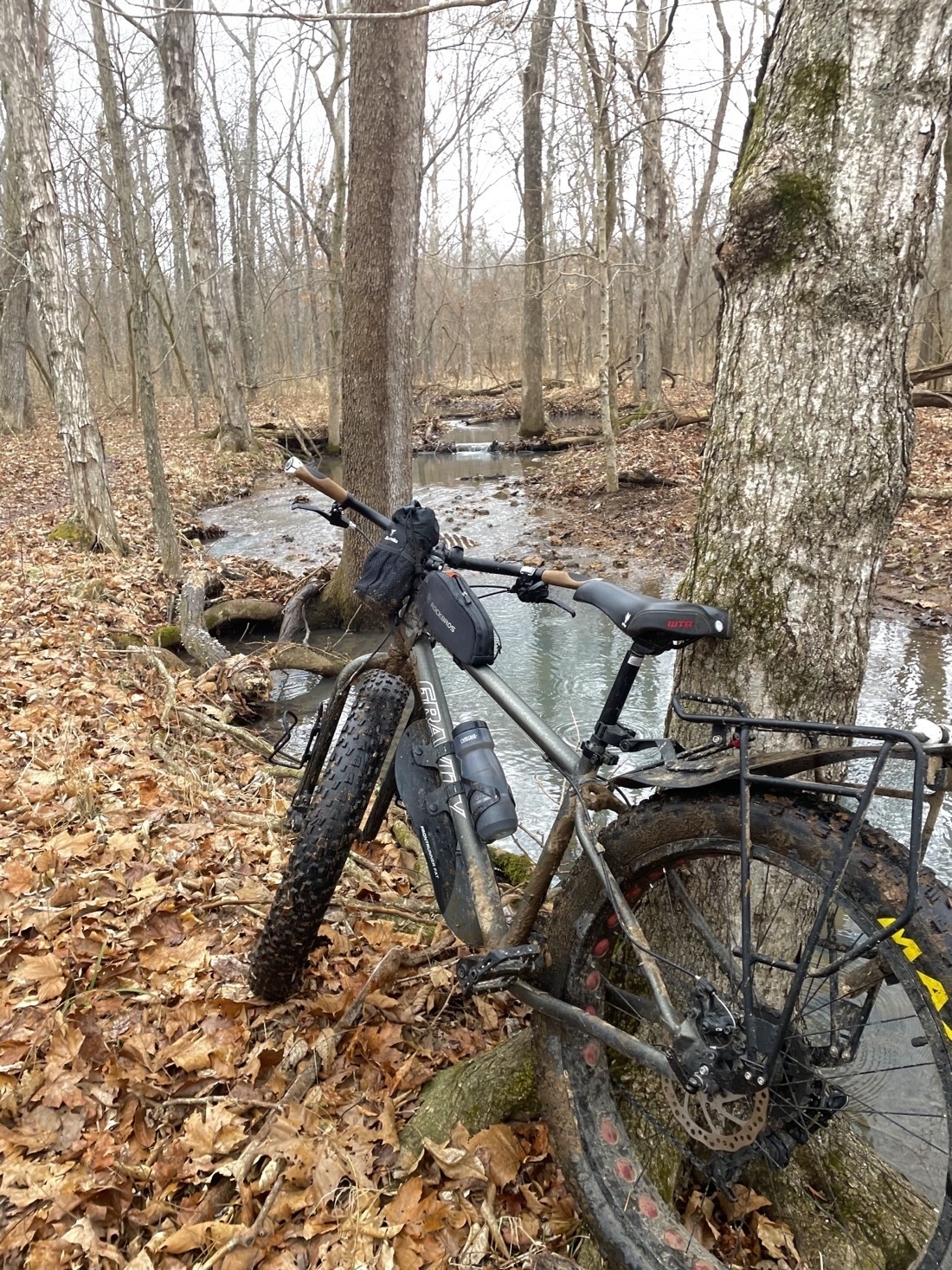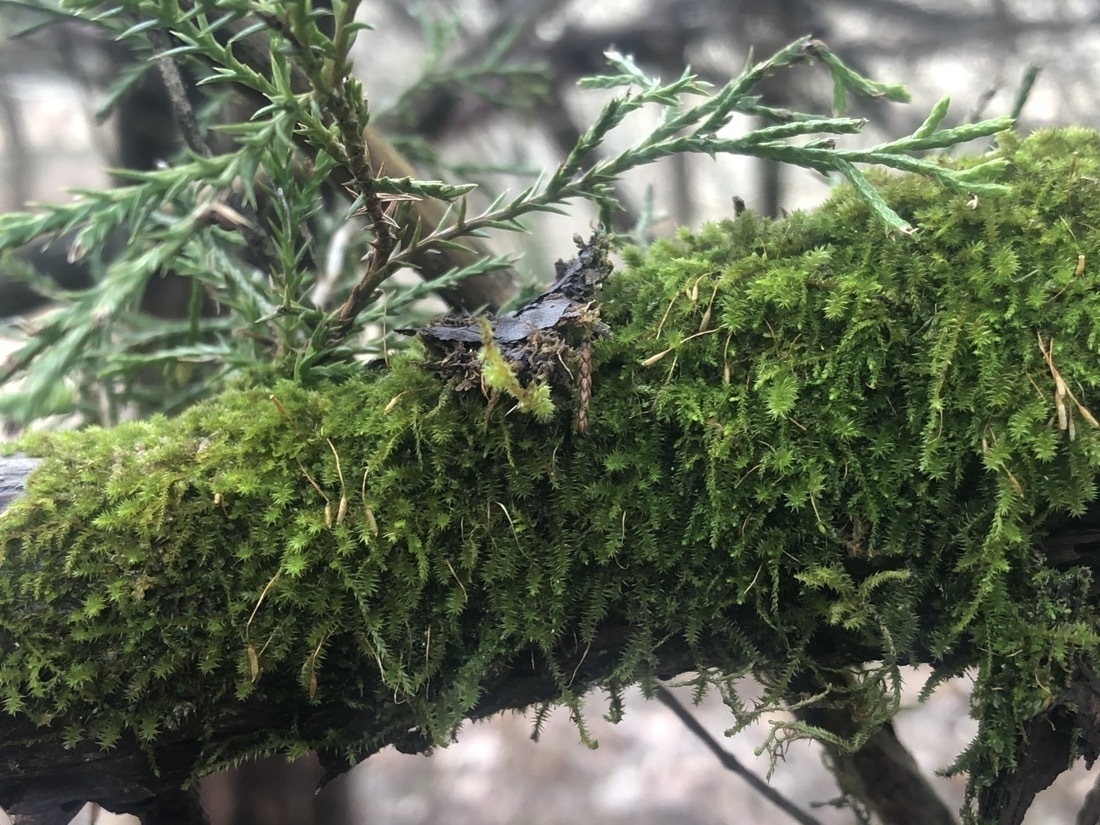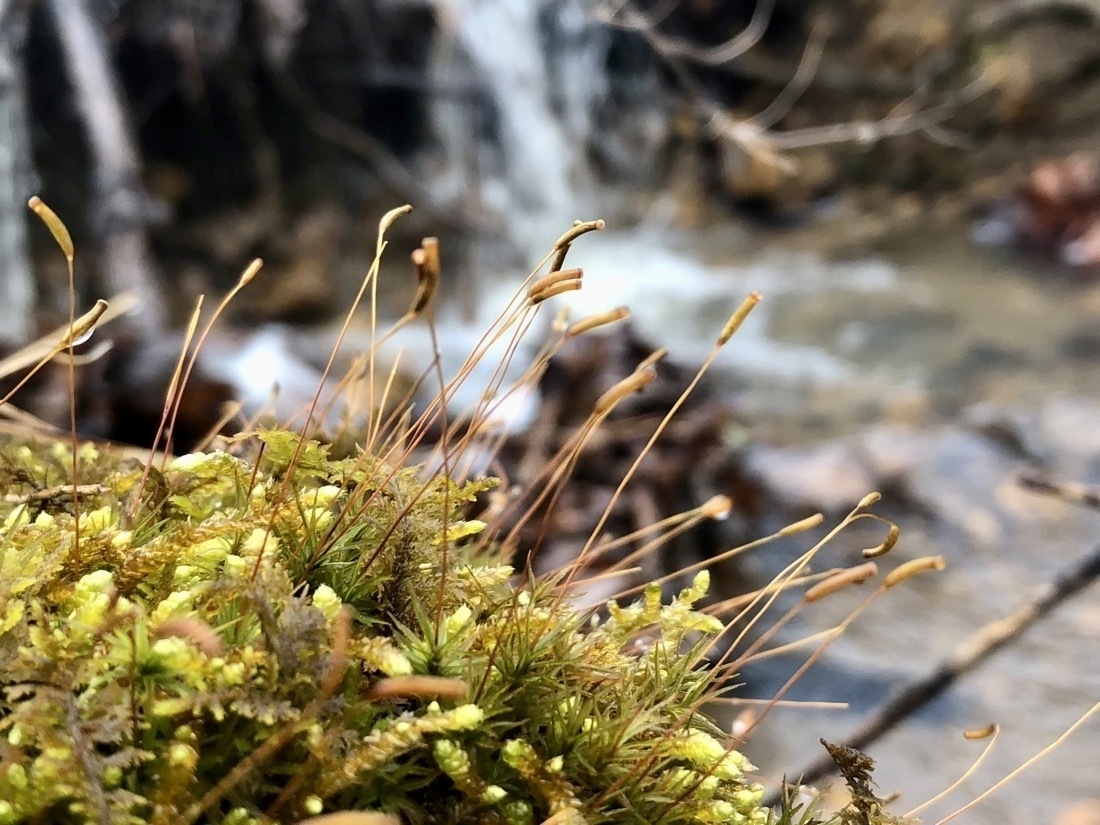Simple Living
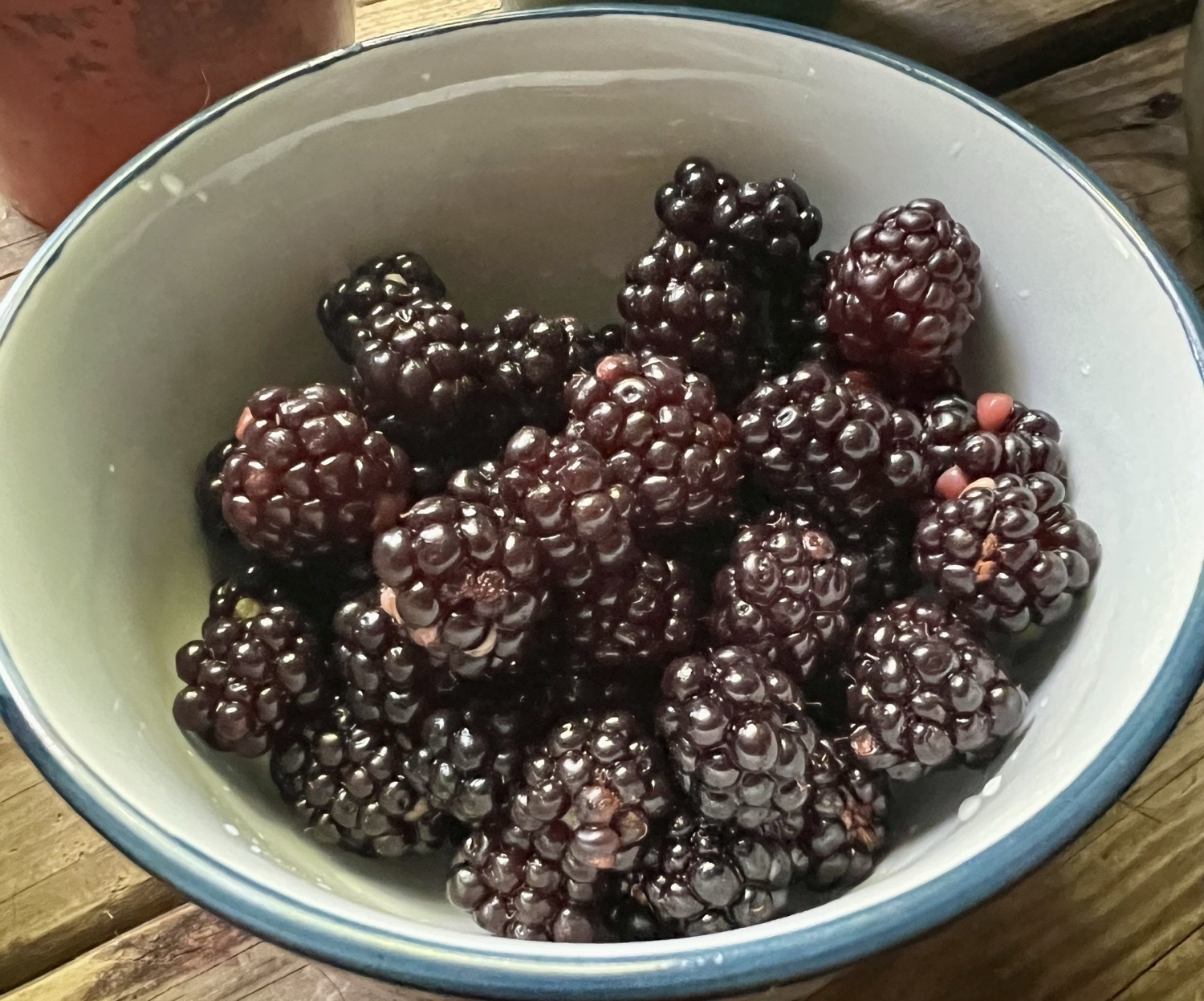
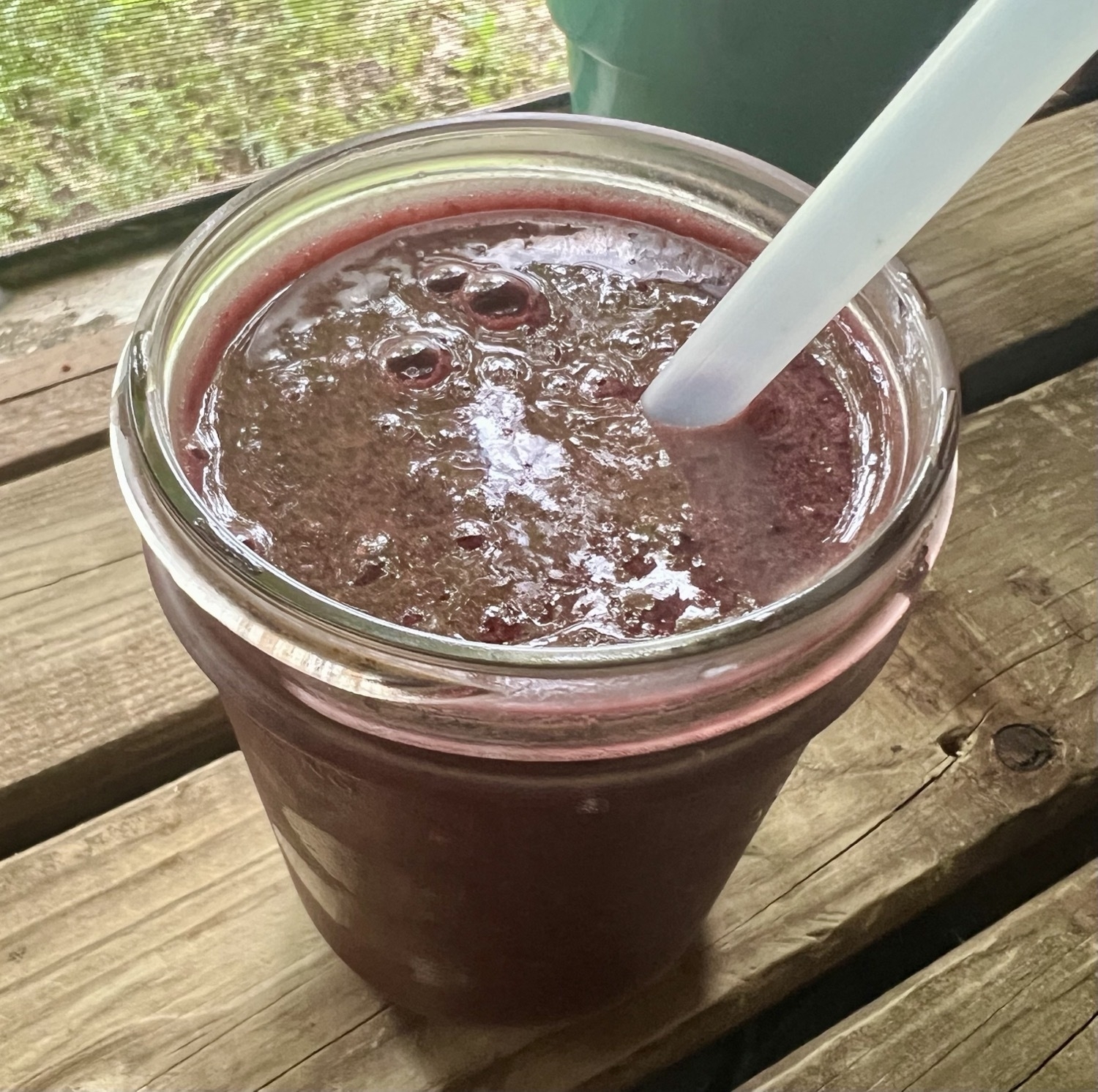
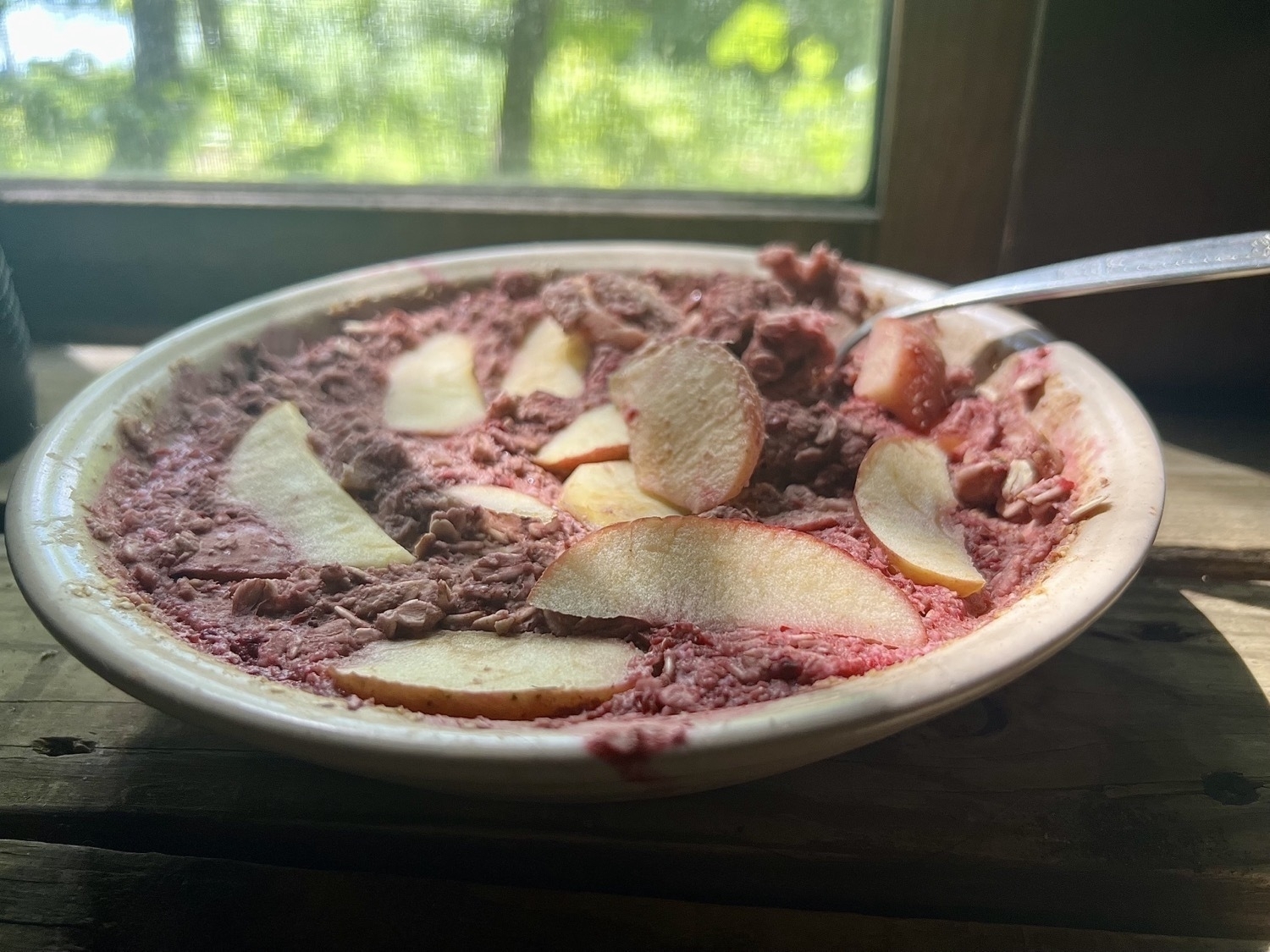
Tiny Life Journal - The first blackberries of the season have been teasing the past few days. I harvested a small bowl today, half for a blackberry lemonade smoothie and half for blackberry-apple baked oatmeal. I eat oatmeal almost everyday, sometimes twice a day. It's at least 30% of my daily calories so I buy it in bulk in 50lb bags. It costs a lot less and I can compost the paper bag.
I say baked but really, it's microwaved because I don't use the oven in the summer as that works against my effort to stay cool. But what I've found is that it's entirely possible to make baked oatmeal in the microwave. A recipe for a one person meal or perhaps a 2-3 serving snack:
First I do this bit: 1/2 cup oatmeal blended into flour with 1tsp sugar, 1/8th tsp salt, 1/4th tsp cinnamon 1/2 cup oatmeal
Then 3 tsp sugar and 1/4 cup soy milk blended into blackberries for a second. Mix that into the oatmeal. It's thick like batter, evenly wet but not soupy like oatmeal. I usually make this without the blackberries in which case I use 1/4 cup soy milk and 1/4 cup water to get the right consistency.
Then slice a small apple or half a large apple. And put it on top, kinda push it into the oatmeal a bit so some is mixed in, some is on top.
Microwave 2-3 minutes. Cover it with a plate and let it sit for 10 minutes.
Life in the woods:
I’m sitting on my futon writing when I hear a sound in the cabin. Rosie (my feline friend) jumps up. It’s a bird that has flown through the open screen door. It circles and lands. Takes flight again and finds its way out the door. Yay! Crisis averted. I sit back down and put my hands on the keyboard to continue and yes, in that one moment of flight in the cabin, my feathered friend dropped a poo. And yes, that poo landed on my keyboard. And yes I put my fingers in it. 🤣😬😆
I opened photos to look for a photo and ended up at some older images.
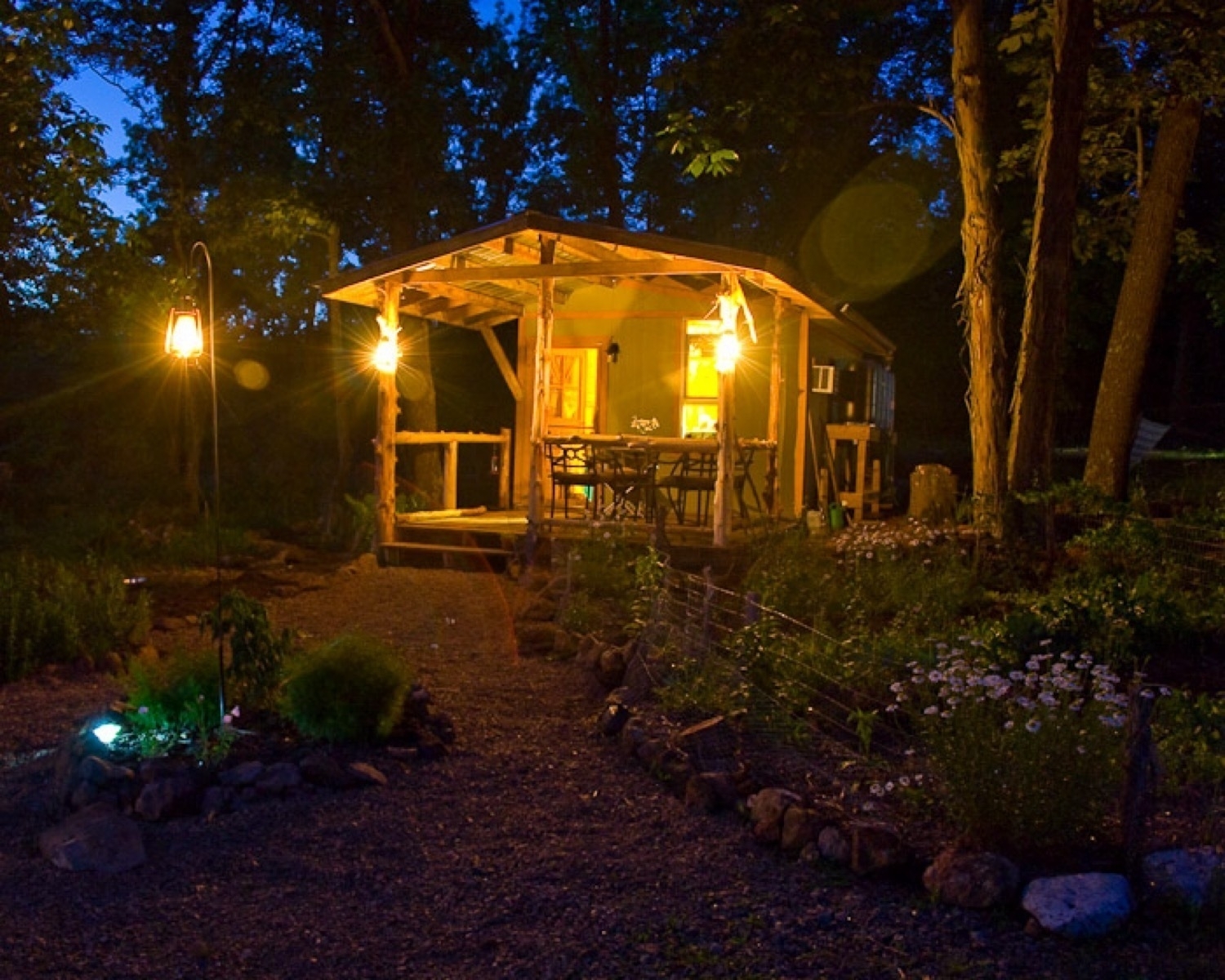 My cabin in the evening.
My cabin in the evening.
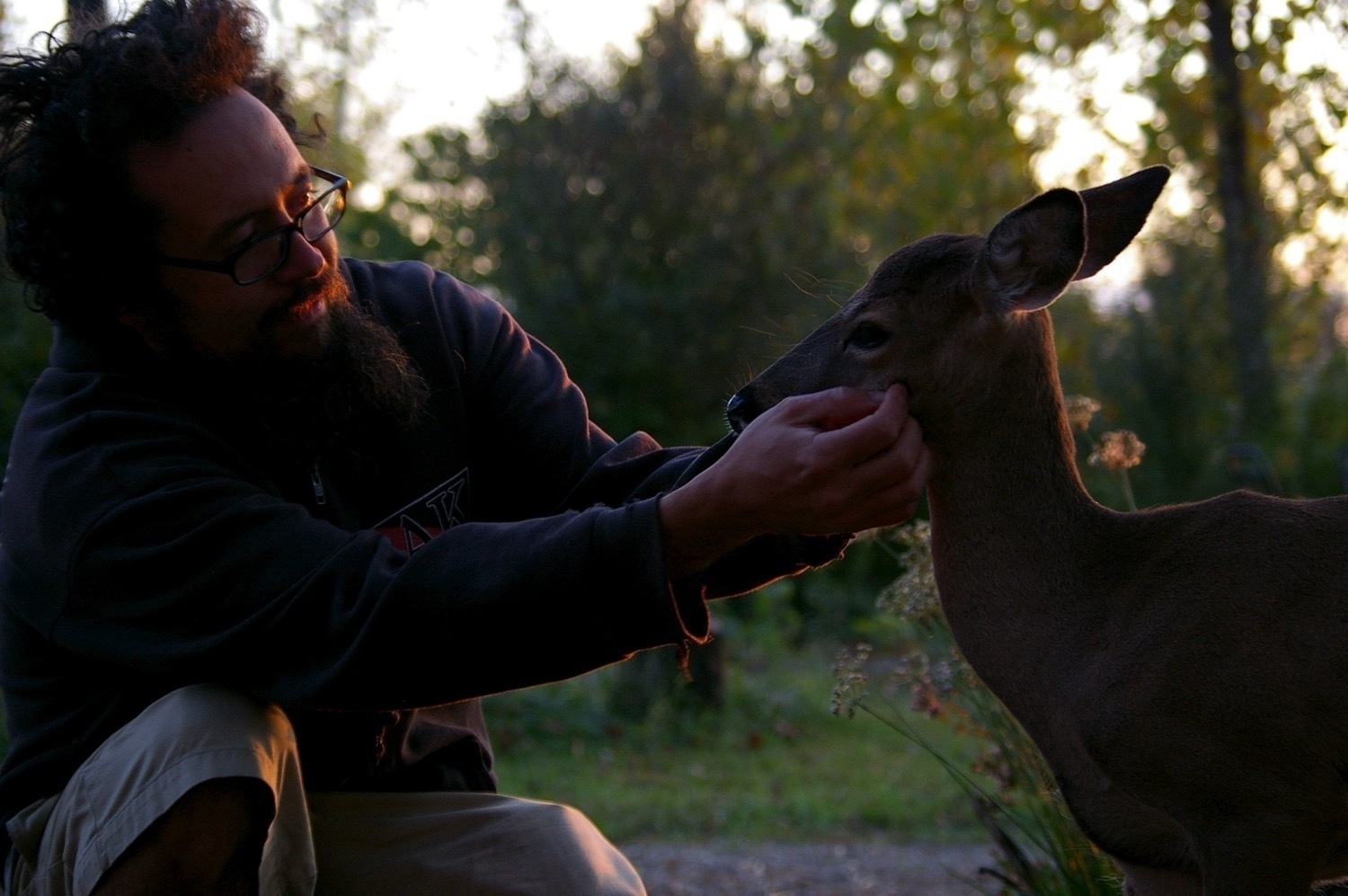 Giving Petunia a neck scratch.
Giving Petunia a neck scratch.
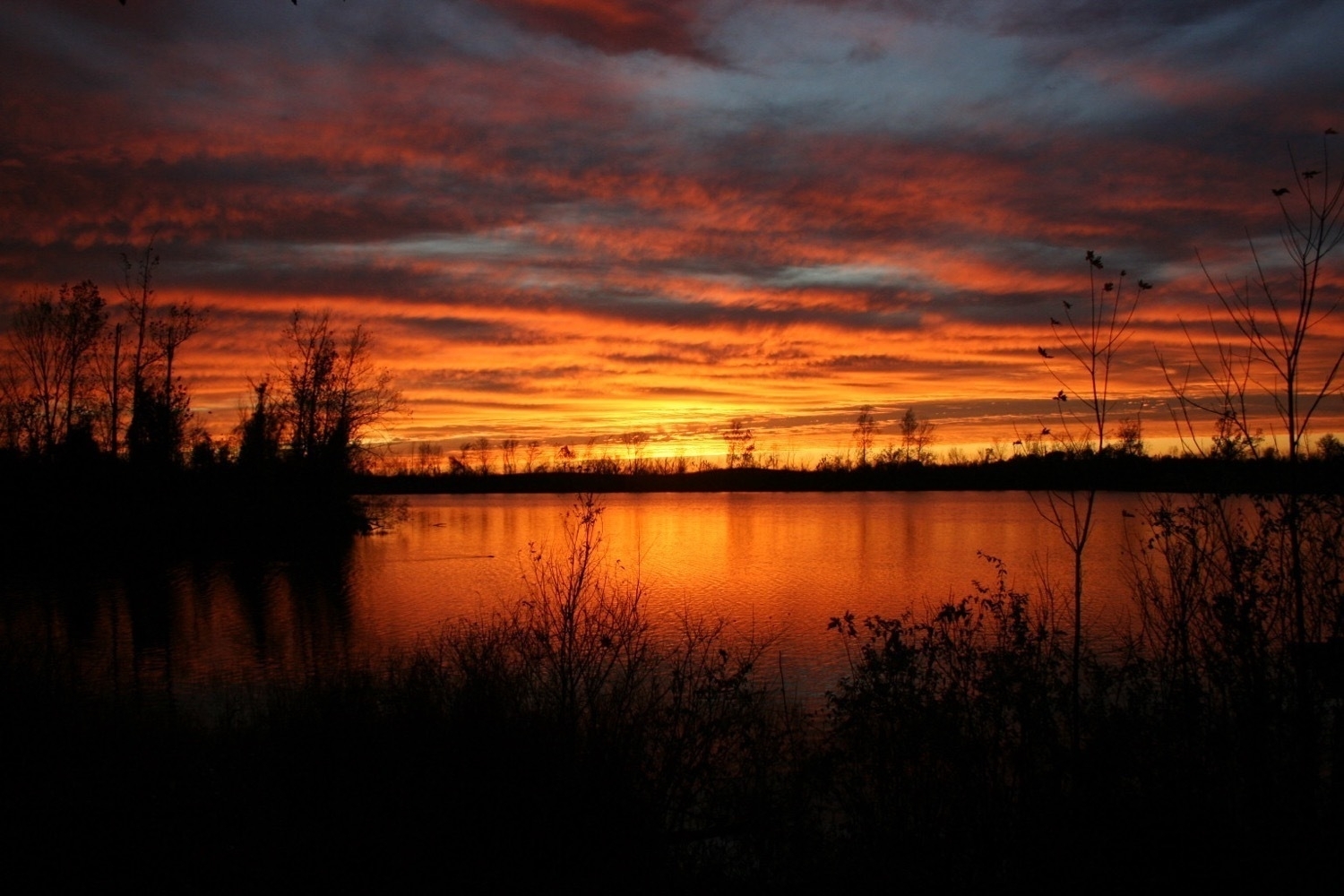 A sunset over the lake.
A sunset over the lake.
My take on a personal climate impact assessment and plan. 🌍
As others have noted in recent similar threads, I'm not suggesting that personal action on climate is the primary or only action needed. Far from it! I'll continue to be a loud-mouthed advocate of action at every level possible. In the past I've helped organize and joined in on a variety of direct actions. As far as I'm concerned we should have immediate short, long-term and ongoing climate strikes with the aim of shutting down business as usual. But while I support collective direct action I'm also a fan of personal direct action because as individuals we all add up. The US is collectively 300+ million people. If those 300 million people made a real effort to make changes, well, they add up to an entire country of people making a change. Lastly, the fastest way to make such direct impact is simply conservation. It can be done by anyone today. No barriers other than a lack of effort.
Before I dig in on details, a note about the context. I'm single, no kids, work from home. My tiny house is in a rural setting with nearest town/stores about 8 miles away.
So, my take is, let's do this and stop making excuses. Here's my PEAAP (Personal Environmental Action Assessment and Plan)
Transportation/Traveling
Local transport for home supplies and groceries
I have an older, 2007 Toyota Matrix, gasoline. At my current rate my mileage for 2023 will be around 110 miles, about equal to 2022. In 2020 and 2021 my miles were closer 200 each year as I was making more trips to town for a home-bound family neighbor who I shopped for. Going forward I'll keep my present course which amounts to 1 trip to town every 7-8 weeks. When I do drive I focus on efficiency. Slow acceleration, coasting, etc.
I've got several extended family/neighbors within about a mile that I visit and this is either done by foot or bike. I'd thought/planned to switch to a bike for grocery runs to town but I have 2 dogs and a cat so for now I just plan my grocery trips to coincide with resupply of their food which typically get's purchased in fairly large bags.
I don't do air travel (or much travel really) so no flying to report other than two trips back before 2001. I've taken Amtrak and were I to need to travel any distance in the states I'd look to Amtrak if possible.
Housing
I've been living in a 200 sqft tiny house for most of the past 15 years. It's located under mature trees in an area that is predominantly shady due to a pre-existing woodland which helps a great deal during the summer. Location is Missouri so fairly hot and humid.
Heating is currently an electric oil radiator and on average is kept at around 62° F daytime, 58° night. I'd like to get this down a bit lower. I bundle up in the winter, it's easy and cozy. Also, I'm in the habit of going for at least one dog walk a day, often two. And in the winter I find that after a walk I'm warmed up for at least an hour after. In addition to the heater I have a heat tape that is used to keep pipes from freezing in the small, covered space where my water pipes enter my cabin.
I also have a well house that has to be heated when outside temps drop below and stay below a certain temperature close to freezing. I've made this far more efficient in recent years, It's a small space. I use a fan and an electric oil heater. I've got a remote thermometer and smart plug. When the temp in the well house drops below 34 the heater and fan go on. When it hits 38 they go off. Also, heat tape for the pipes in the well house to keep pipes from freezing in the outdoor section.
During the summer my cabin is cooled by a mix of fans, outdoor air when possible. Once it get's hot enough outside that I can't keep the cabin below 79° I use a window AC at which point the average temp is around 77°. As much as possible I monitor and adjust. When it's cool outside I turn off the AC and open windows for fresh air, especially at night. It's a balancing process that also includes monitoring humidity. When the AC is on I find that a two fans easily allow me to be comfortable at 77°.
Cooking is mostly a microwave or small electric induction cooktop. I also have a small propane stovetop/oven for power outages and a small amount of baking in the winter. A small refrigerator/freezer for food. It's not mini but perfect for full time living and one person.
No hot water though I do use hot water to shower in a neighboring cabin that belongs to my sister and brother-in-law. I don't shower nearly as often as most people.
I have a mini wash machine for laundry, hang to dry.
I have a solar panel and battery for charging my iPad, iPhone and a set of USB string lights. It's also what I use to charge 4 batteries for a lawn mower which is used for various patches of grass. I'm generally not in favor of grass lawns and mowing but am currently trying to manage/remove an invasive plant, lespedeza, that has to be mowed. The alternative is to let it take over any open area which would be a signifiant loss of native species. So, I'm mowing minimally in areas that require it for foot traffic as well as to remove lespedeza.
My current average use of electricity is about 9 kWh per day which could come down a bit but probably not too much as that's mostly heating and cooling and I think I'm going about as far as I can go.
Food
I've been mostly vegetarian for the past 33 years. Exceptions to that include occasionally eating some fish from the lake near my cabin. For a short time I also ate small amounts of venison when hunted by family. And when I come across leftovers from family I'll eat that whatever it is. I'd rather eat it than see it wasted.
In the summer I avoid cooking in the cabin as much as possible. I'll use the microwave but if I want pasta or anything that needs to significant time I'll do it in my little outdoor kitchen. Much of my summertime diet is easily done with no cooking.
In the winter I cook as much as I need as any residual heat helps keep the cabin warm.
Beverages: I stopped buying any kind of drink that comes in plastic, glass or aluminum. Currently I buy the following drink related products: pre-ground coffee, bulk spices for tea, paper containers of cocoa, soy milk and non-dairy creamer both of which come in lined paper cartons. Currently experimenting with composting those.
My primary rule of food consumption is to only purchase food that comes in steel or paper. I do allow for food that comes in plastic bags such as popcorn kernels, bread and tortillas. All other food comes in paper/cardboard or steel. This has allowed me to cut consumption of plastic to near zero. Exceptions to this: coffee which comes in a kind of vacuum packed plastic and vinegar that comes in plastic and is used sparingly.
In general I look for ways to reduce packaging for food and other household products. Example: I consume a LOT of peanut butter. After saving up quite a few wide-mouthed glass jars that peanut butter comes in I started buying bulk peanuts in 20lb bags. Every 10 to 14 days I just blend a new jar of peanut butter as I use them. It's minimal effort and 10 minutes at most. That leaves 1 plastic bag that I use over the course of several months to collect what little trash I have.
Personal hygiene and household products
Bar soap that's packaged in paper covers 99%. In the past I've very sparingly used dish soap in a plastic container but have cut this to near zero. I have a jug that I've had forever and only use it when I must. Toothpaste and deodorant both come in throw away packaging. For laundry I use the laundry strips.
Clothing and footwear
I almost never buy new clothing. Underwear, that's about it. Most of my current clothing is just stuff I've had for years or stuff that was given to me by family that were cleaning out closets. I've had to buy 2 pair of jeans over the past 5 years. Currently I've got several pair of boots that were donated by above mentioned family. Other shoes I've purchased. I walk A LOT so over the years I've gone through what I expect is more than the average consumption of shoes. That said I wear them until they are, literally, falling apart.
Electronics
This is the area of personal consumption that I most need to improve.
My current flat screen LED tv is most certainly going to be my last. It's 4 years old but at the moment my plan is to not replace it. Instead I'll use an iPad or secondary computer display as a tv instead. That's what I'm doing currently and it works fine.
My day-to-day computer is a 13" iPad Pro. It's the 2021 model and I expect to use it for at least another year or two, possibly longer. I'll keep current iPhone for much longer. I have a Mac Mini (2021) that is usually turned off or, if on, is functioning as a file server. It will likely be the last "computer" I buy as it's a device I have as a back-up for work should the iPad fail for some reason.
My plan for electronics devices going forward, as it's been in the past, is to minimize frequency of upgrades as much as possible. I don't have a hard rule on this.
Conclusion
I'm using far less than the average citizen of the US but still using more than the average used in many countries. Just having a refrigerator, window AC and heater put me in a category above most of my fellow humans and thus, more than my share in the global context. That said the vast majority of my fellow humans are using far less than their fair share. There's a balance to be found somewhere far below the average energy/resource consumption in the US but also above the lowest.
Others posted in recent weeks: Michael's PEAAP
One of the tasks of rural life is gravel road maintenance. I don't have a tractor so I do small bits by hand. The task in this section: remove the center hump and allow for water to shed off the down-hill side. 2 days, 3 hours. 1 more day and 1.5 hours should get it done. Excellent exercise!
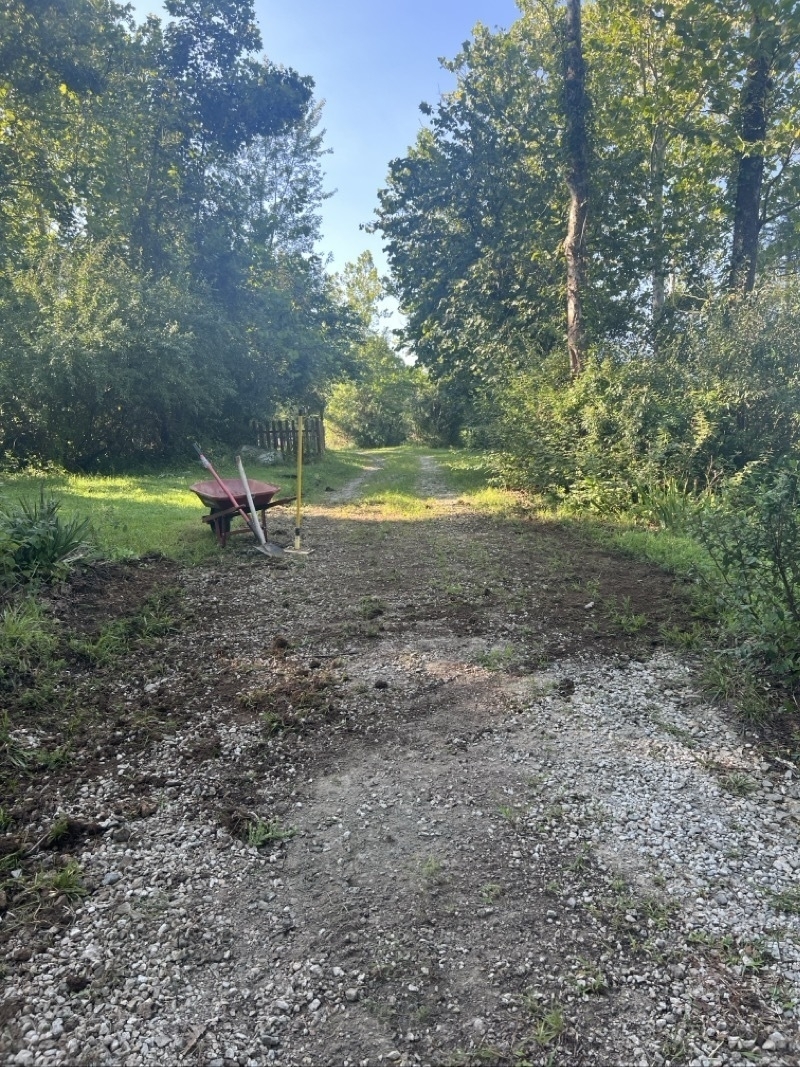
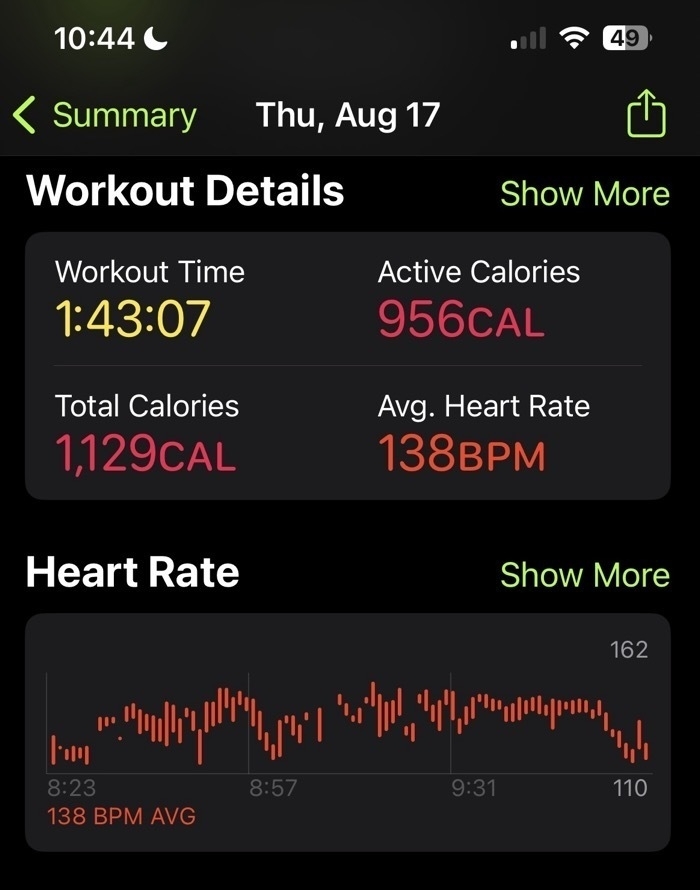
A small, energy efficient laundry machine for a tiny house or other small space.
In the early 90s there was a television show called Northern Exposure and in one episode one of the characters was debating getting their own washing machine. They were resistant because they enjoyed the social aspect of going to the neighborhood laundromat. Why use natural resources for a tool that could be had in a communal setting? As a conservation-minded, community-oriented activist that resonated with me.
Fast forward to 2022 and I’ve been living in my tiny house for 12 of the last 14 years and it was only yesterday that I finally did a load of laundry in my own washing machine. In previous years I either used a laundromat in town or I’d wash when I visited with my folks who are also nearby neighbors.
I’ve thought off and on of getting my own washing machine but in a small tiny house the choices are limited. My folks are planning to move and rather than automatically revert to a laundromat in town I went looking again to see what might have changed since I last looked over a decade ago. I was surprised to find that there are now fairly small top loading washing machines optimized for small spaces. They come in several sizes but in general, compared to a standard washing machine they’ll do a small to medium load. I decided to try one of the larger options in the hopes that I’ll be able to wash a small blanket when needed.
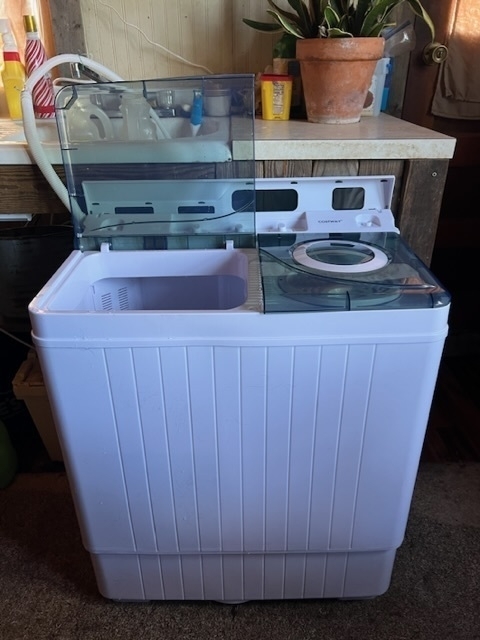
I’ve only done one load of laundry but thought I’d offer up a mini review. Obviously this doesn’t speak to the longevity or durability but I think I can comment on the effectiveness and usability . The machine I purchased has left and right sections. The left side for washing will take up to 18lbs and the right side for “drying” via a spin cycle takes up to 8lbs at a time. I did a medium load with was pretty typical for what I need to do: a few hand towels, wash cloths, socks, a couple pillow cases, a couple t-shirts, a sweatshirt, padded cycling shorts, and some underwear. I could have done a full load and added in a towel or a few more t-shirts. I’ll have no problem doing a full-sized sheet and a few clothing items. A small blanket should be fine to wash, not sure if it will fit in the spinner.
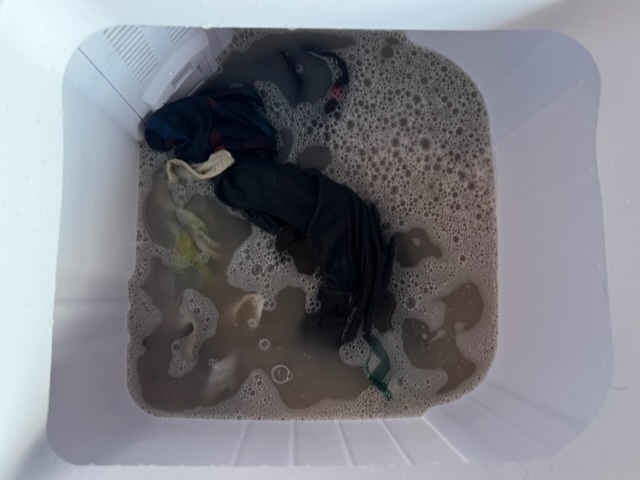
Some of these machines drain via gravity and require that the hose be level with the machine to drain out the water. The machine I bought has a pump and so the hose can be elevated to a sink to drain. I did a 10 minute wash cycle with soap then drained it and did a 10 minute rinse. The machine offers a forceful, efficient movement of the water during the washing process. The water after the soap cycle was obviously dirty and the water after the rinse cycle was clear. I divided the load into 3 for 3 different 3-4 minute spin cycles. The result was exactly what I hoped for: clean stuff that was fairly dry. Given the colder weather I hung most of it up to dry on a clothes line in my tiny house.
These are fairly energy efficient, maxing out at 280 watts so could be used with a solar/battery off grid system without too much drain for an average load. Assuming it holds up for several years I’ll consider it well worth the $200 cost.
An unexpected and very pleasant surprise this morning!  Add a mocha, the Vince Guaraldi Trio Peanuts Greatest Hits and a purring cat to my lap: 😊
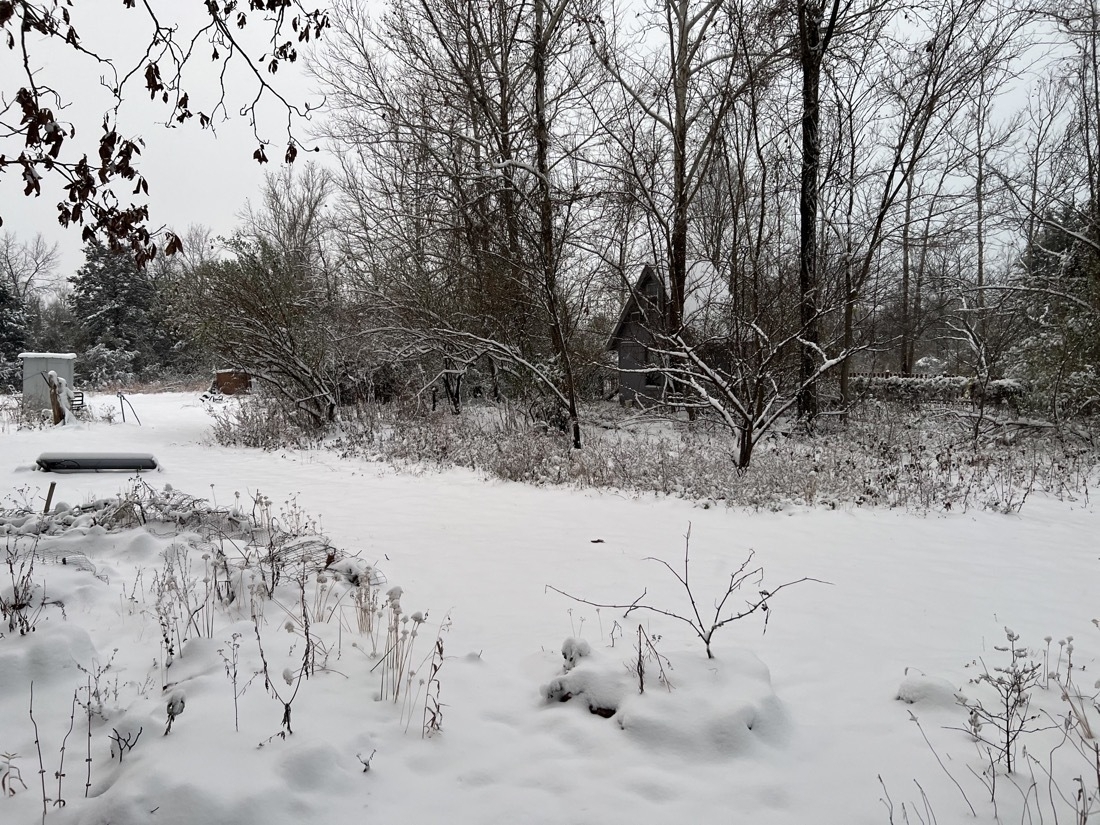
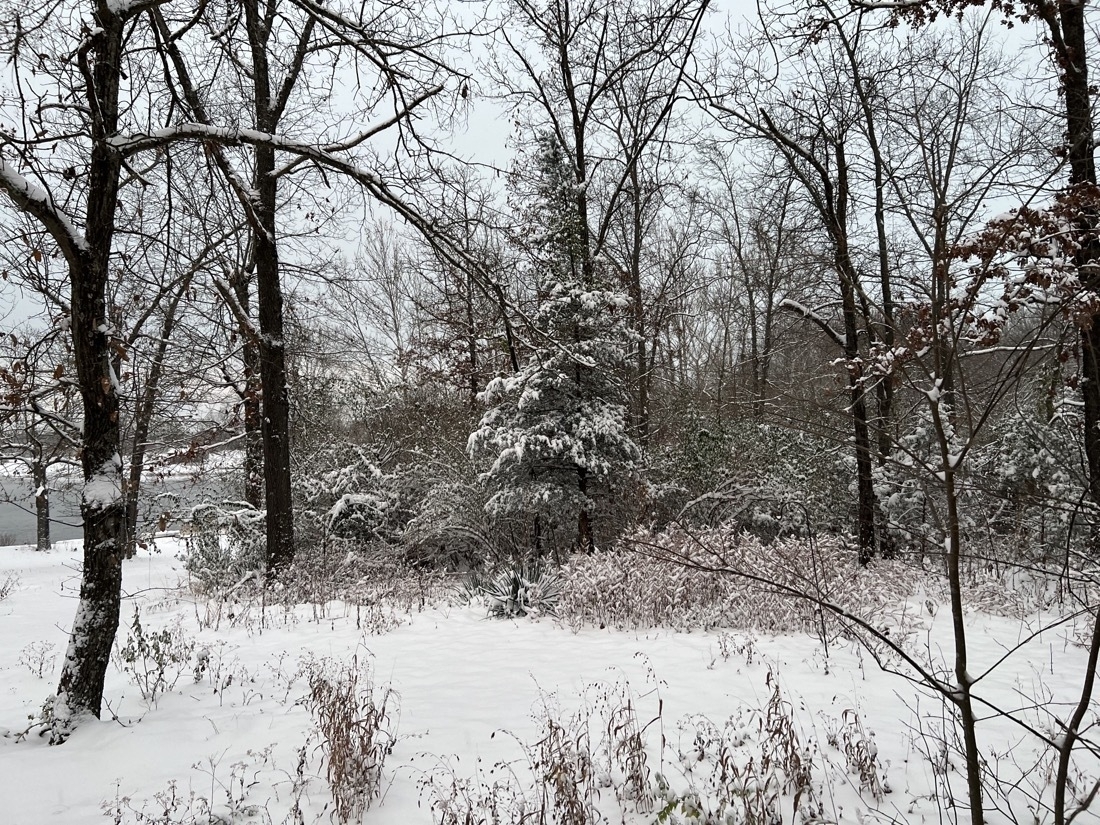
Made my favorite fall/winter soup today: Curry pumpkin-coconut -vegetable. Cube 2 to 3 cups of raw pumpkin without the skin and boil for 30 minutes “. Blend or mash it in the boil water.  Add 2 to 3 tablespoons of curry powder, teaspoon of cayenne pepper, and a tablespoon or two of salt, garlic, a sautéed onion and 3 cups of frozen mixed vegetables.  Simmer for 15 minutes then add one can of coconut milk and 2 to 3 cups of cooked or canned chickpeas and simmer for another 15 minutes.
The end result is sweet and spicy and super tasty !
Bird Song
A small thing that I enjoy everyday but have rarely if ever mentioned here: bird song. Sitting here this cool morning with my windows open and I’m listening to what may be a blue-gray gnatcatcher. A tiny little bird. Other times I listen on the trail when walking or riding. It’s fair to say that bird song is one of my favorite things.
Exploring on two wheels
I’ve been thinking about my journey these past 12 years since moving to Madison County. The first 4 years focused on the homestead project, building the cabin and the gardens. Then several years focused on astronomy, looking through an eyepiece up into the night sky and thinking constantly about the universe, trying to develop a better understanding of the cosmos and my short time in it. And that brings us to now. I’ve spent the past 8 months having mini-adventures, daily explorations on two wheels around the local countryside. From trails to paved roads to gravel roads, I’ve been riding through farmland and forests and everything between.
A common thread throughout the past 12 years here seems to be a mix of adventure, exploration and a seeking to understand the world I exist in. In the first few years I was focused on my immediate surroundings as I created a home, gardens, and generally sought to fit into this landscape. The adventure was extremely local. Most of my time was spent within 1/4 mile of my cabin and thinking about the life within this 1/4 mile radius. Most of my days were spent doing garden work or something related to creating or building the homestead. My free time was often spent walking and observing.
Then I began a transition to spending more time looking through the eyepiece of the telescope. Looking into the cosmos and finding the beauty there. To some smaller degree I kept up the garden but my mind and my thoughts were oriented outward. In the day I read and pondered what I was seeing at night as I looked at galaxies, nebulae, planets, and star clusters. I would stay out 5 to 8 hours every night that was clear of clouds. I can’t explain what led me to that pursuit. But I think it’s interesting that my thinking, attention, time and effort shifted from what was immediately in front of me, plain and simple, to distant astronomical worlds and objects, and thinking about the complexities of cosmology, physics and related sciences. Not that I understood everything I read but I made the effort to dive deep (or what seems deep to me).
Likewise, I’m now spending hours every day peddling a bike around the back country roads of Madison and neighboring counties. I’m not quite sure how this happened. I bought an electric bike and rode it to town the first day I had it. Then I rode it to town the next day and the next. A few weeks later I started looking at the map and rode further into the county and the next county over. By February and March I was taking two and three hour rides just to get out and breath the air and to see what was going on in the woods that these roads were built through. Over the summer I retreated to our own woods as I built trails through them for cycling and walking. And now, again, I’m back exploring further out on 40 and 50 mile rides.
I’m not sure what to make of it really other than to say it feels good. Part of my motivation is personal health. For most of the past 12 years I’ve made it a point to get out for daily walks. At the end of 2019 my walking time increased dramatically, almost double my usual. I’m not sure why but perhaps the cycling was my mind searching to go further afield. I don’t think it was a conscious thing but it’s what happened.
Like most kids I had a bike and rode it a good bit. As an adult concerned about climate change the bike was my main transport during my college years and after. From grocery trips to laundry to work to random errands, I cycled most of the time. And then I had a knee injury in 2000 and my cycling became painful, uncomfortable. Now that I’ve discovered that I can cycle again I feel like I’m making up for lost time on the bike. 20 years away from my two wheeled friends! I have to remind myself to be careful, to not ride too much or too hard. I’d like to think that if I’m careful I’ll be able to ride for a good long while. We’ll see but for now I’ll just accept it and remain in gratitude that I’ve returned to peddling forward with two wheels beneath me.
Of legends and fuck-ups
The point of this particular story is to begin a recounting of some of the memories that surfaced as I wrote her. Earlier today I was out walking my new canine companion Cosmo and I mulled over a particular paragraph in one of the above mentioned emails. In particular I was responding to something she’d written that hinted that I was settled down. That adventure and growth was no longer a priority for me but that it was for her. Well, it made me angry. Perhaps I’m sensitive because while I’m a bit older than her, at 46 I’m far from joining the Fuddy Duddy club. But the more I thought about it, not just who and where I am now but who I've been, my anger turned into a kind of amusement. I had a pretty good chuckle at myself. I’m a fucking legend. Well, my college advisor once told me that I was a legendary fuck-up. Does that count? Probably not.
I've decided it's time to write down a few things that I’ve probably not shared with family or friends. I know for a fact that much of what I might write will be news to my family and at the very least I’d like them to know these things. Not that I’m anything special, but as much as I want to know my fellow humans it’s also nice to be known. It’s nice to share and I think I’ve lived an interesting life, or, at least an unconventional life. I might make this a series of posts over the next few weeks. Of course, I often contemplate such themed posts but never get around to it. But this is the first time in a long while that I’ve really felt the urge to write. Maybe it will stick. I think I’ll leave out the racy scenes for the moment. Not sure I should really get into that. Ha! Maybe I should. Any good story that purports to be about a legendary life should include a bit of the spicy stuff, no? I’ll contemplate that.
Perhaps this will serve as an overview and future posts might be an elaboration? Sure, that sounds doable. So, what kinds of activities and life choices might be examples of an unconventional life? Let me offer up this as a sampling:
I’ve been to jail for pirate radio broadcasting on a rooftop and I’ve had to kick beer guzzling pirate punk rockers out of my home. I’ve lived with beer guzzling pirate punk rockers. I once woke up to a flaming couch outside my door and then proceeded to drag said couch until my fingers blistered and bled to keep my house from burning down. It wasn’t just smoldering, it was in full on flames. I’ve been in sweat lodges and fed hundreds of homeless people. During my time doing work for political prisoner Leonard Peltier I camped outside a federal building for a week and quite literally told the FBI to go fuck itself. I’ve drummed and marched with thousands of people at multiple rallies in DC and helped kids in Memphis fix their flat tires. I’ve helped make two documentary films and been on the crew of various others. I once took a midnight tour of the Civil Rights Museum in Memphis. Eeeeeerie. They were closed but we were outside showing some traveling activist friends where Martin Luther King was assassinated and the guard came outside and invited us in. Maybe he did that all the time for anyone but we felt pretty special. I’ve literally faced down a screaming, hooded clansman and been teargassed by the police. I’ve interviewed rockstars on their tour bus (do Chumbawamba count as rockstars?) and helped teach illiterate adults how to read. I’ve helped put in at least 7 different community gardens. I’ve organized conferences and taken phone calls in the middle of the night from someone issuing threats through a voice altering device. I helped found a housing co-op that I lived in for 5 years during which time I lived with over 50 different housemates and hosted 240+ travelers and two different activist oriented conferences. I’ve raised a baby deer and seen it return to the wild to have it’s own babies. I’ve raised my own poultry and on a couple of occasions butchered them for food. I helped organize two indy film festivals. I helped found and run a micro-radio (pirate radio) station for 2 years. Said station ran out of our home and hosted 50+ volunteer DJs during it’s time on the air. I once misjudged the duration of an acid trip and ended up working my first night as a barista at a coffee shop at the peak. I pulled it off and went on to co-manage the shop a few months later.
Maybe I’m still hallucinating but I don’t think that’s a typical list of life activities. And it’s just a small sampling. I just wish I’d had an iPhone for that period of my life so I’d better remember more of it. And to emphasize, this isn’t so much as a self-congratulatory pat on the back or bragging about past deeds so much as my not wanting to forget them. And also as a way to be better known. Many might look at that list and see things to be ashamed of. It is what it is. For the most part I don’t regret my life choices. I’ve made more than my share of mistakes but a life without mistakes is probably not very well lived. I believe in the notion of admitting a bit of foolishness into our lives and, even more, celebrating it (hat tip to Steve Jobs).
To make sense of any accounting of deeds and misdeeds it often makes sense to order it as a chronology of sorts. It seems smart to start when things took a turn from the typical and that was, for me, college at Truman State University. Why don’t we start with that cranky advisor that I mentioned above. He thought I was goofing off far too much. He thought I could and should take academics far more seriously. Maybe he was right. I was working on my BA in anthropology from 1987 to 1992 and for much of that time I was more concerned with my budding identity as an activist. My upbringing was basically very similar to an episode of the Simpsons in that we lived in suburbia and my parents were not very political or religious. I could pick any number of other examples of suburban family life portrayed in popular culture but the point is that it was a pretty average life that emphasized the usual for suburban middle America. Within the context of this typical life I, as an individual, was pretty laid back and not all that adventurous. And totally unaware politically. I had little idea about the workings of government or the historical evolution of culture and politics in the U.S. or anywhere. I thought Ronald Reagan was a swell guy.
| Antioch College students visited the deCleyre co-op two years in a row for their environmental racism and justice summer course. 2001 |
It was chance, perhaps, that got me off on the left foot because I was randomly assigned a biography of Gandhi for freshman orientation for which I was suppose to give some sort of report at a session of said orientation. This was the story of an unconventional life and it stuck to me right off. That’s right, Gandhi was like a big wad of HubbaBubba bubblegum stuck to my shoe. Not that I tried to pry him off. I was content to have him stuck in. His story proved to be just the first seed in a series that would take root in my mind and begin to open my perspective up to a different kind of life. I was corrupted by an adorable little Indian guy that also happened to kick ass (in a very nonviolent sort of way of course).
Within that first year I’d begun attending meetings of the “World Peace Group” and Amnesty International. By the third year I’d discovered the Greens and the Green Party. I’d attended the only environmental club on campus that was focused on recycling and decided they were far too limited, too narrow in scope. I wanted something that addressed not just the “environment” but something more encompassing that went at the social root of ecological problems. I opted to start my own organization based on the larger green movement and simply called it the Northeast Missouri Greens. It was my first step into a process that would lead to a fundamental and radical shift on my understanding of what it meant to be a human being as well as what it meant to be a citizen. I’d never organized anything or spoken in front of a group of people. The room was overflowing at our first meeting and it probably goes without saying that I was a nervous wreck as I spoke to 40+ people, many of whom I’d never met. That was the beginning of my identity as a radical “organizer” and a personal evolution that continued for for over a decade and which continues in some ways today. I’m no longer involved with radical community organizing but as recently as 2010 was active in a local “mainstreet” revitalization organization in our local town. My hope then was to guide the group towards the “Transition Town” model of organization. Sadly the group disbanded after disagreements regarding how to address problems with the local police force. One of our last projects was the creation of a local space for art and culture which hosted poetry readings and art openings as well as discussion groups and even a dance party. Good times.
Since 2012 our little community (within the larger community) has evolved. Our activities, open to all, range from monthly community potlucks to star parties. For awhile I did a series of astronomy presentations at the local library but that’s been on a hiatus for over a year. The point though is that while my personal life is no longer one of a green-anarchist activist in a college town or city, it is still one of engagement. While I’m not opposed to participating in a protest or activities of a more radical nature my role of late has been to try to nurture the practice of creating community, specifically a community of people that tend towards skepticism, atheism and science. It seems like a good counter to the anti-rational and often anti-science culture of religious rural Missouri.
In a way that is a summary of it all with a bit of the beginning and a bit of the end or, more accurately, the present. I’m looking forward to sharing some of the details of the adventures that happened in the middle. The stuff of legend? I may have exaggerated but I will say that at the very least it has been an adventure.
Oh, and for the record, I’ve known people well into their “golden” years who have persisted in living full lives in every way they possibly are able. I intend to be one of those. Life is meant for living and if I’m going to take up space on this planet I’ll not waste it. So, as I do age, I'll not be one that pretends otherwise. Aging is a part of the process. But I'll also not be one that stops adventuring. Not unless I have to and as long as I have some mental clarity, well, I won't have to.
Finding Paw Paws
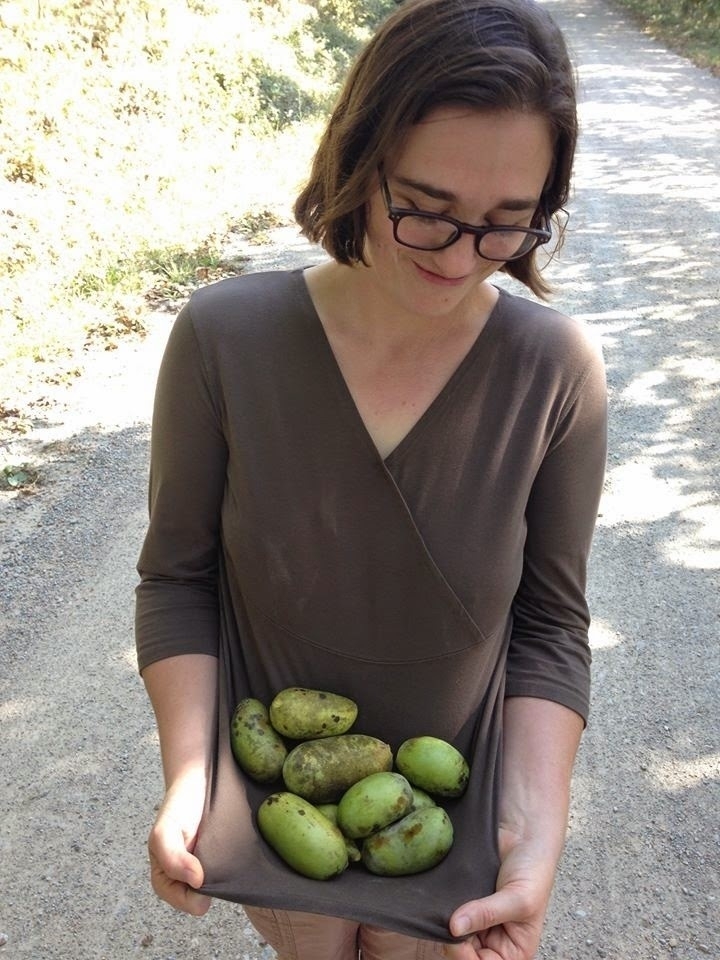
So we're on our walk this morning and Kaleesha stops and says she smells paw paws. This woman has a really good nose! 10 harvested!!
There's nothing quite like the sweetness of a simple life lived deliberately.
